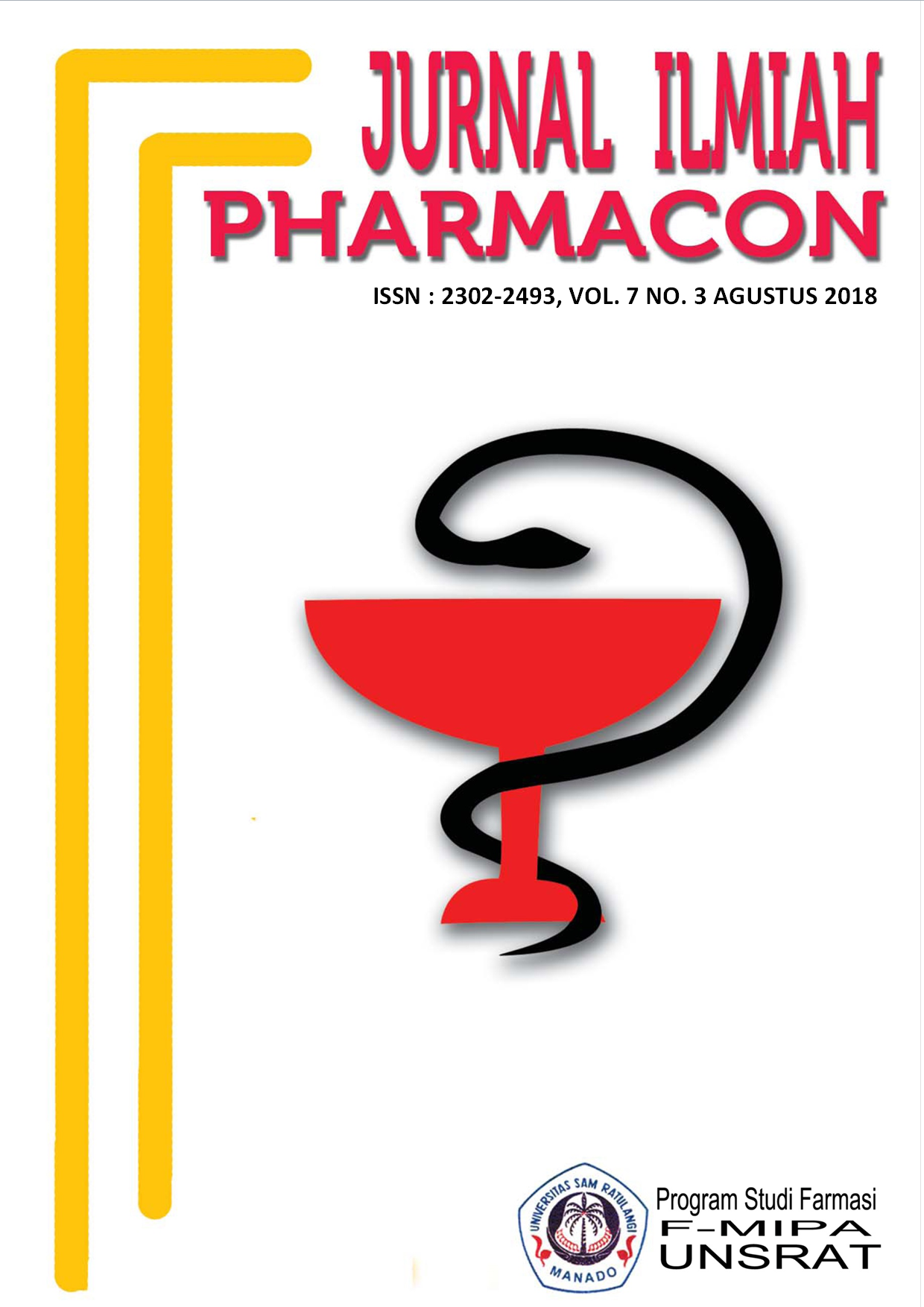EVALUASI PENGGUNAAN DAN OUTCOME TERAPI OBAT ANTINYERI PADA PASIEN DIABETIK NEUROPATI DI INSTALASI RAWAT INAP RSUP PROF. DR. R. D. KANDOU MANADO
DOI:
https://doi.org/10.35799/pha.7.2018.20242Abstract
EVALUASI PENGGUNAAN DAN OUTCOME TERAPI OBAT ANTINYERI PADA PASIEN DIABETIK NEUROPATI DI INSTALASI RAWAT INAP RSUP PROF. DR. R. D. KANDOU MANADO
Ririn M. Tambirang1), Weny I. Wiyono1), Marina Mamarimbing1)
1)Program Studi Farmasi FMIPA UNSRAT Manado, 95115
ABSTRACT
Diabetic neuropathy is a symptom or a sign of peripheral nerve dysfunction, the presence of both clinical and subclinical disorders, which occur in diabetes mellitus without the cause of other peripheral neulropathy, this neuropathy disorder includes somatic and autonomic manifestations of the peripheral nervous system. This study aims to evaluate the use of anti-pain medication in patients with diabetic neuropathy at inpatient installation of RSUP Prof. Dr. R. D. Kandou Manado, based on the type of anti-pain medication used and outcome of therapy. This study was a cohort study with observational and conducted prospectively of 20 diabetic neuropathy patients who met the inclusion criteria. The results to showed that patient received single anti-pain therapy were 14 patients (70%) and combination of anti-pain medication were 6 patients (30%), 8 patients given a single anti-pain medications has improved conditions, while in 6 patients were given a single anti-pain medication hasn’t improved condition, and in 6 patients given anti-pain drug combination experienced improved conditions. Among the 20 patients, 14 patients (70%) has improved conditions and 6 patients (30%) hasn’t improvement.
Keywords : Diabetic neuropathy, Evaluation of painful medicine, Treatment outcome.
ABSTRAK
Diabetik neuropati adalah gejala atau tanda-tanda disfungsi saraf perifer, adanya gangguan baik klinis maupun subklinis, yang terjadi pada diabetes melitus tanpa penyebab neuropati perifer yang lain, gangguan neuropati ini termasuk manifestasi somatik dan otonom dari sistem saraf perifer. Penelitian ini bertujuan untuk mengevaluasi penggunaan obat antinyeri pada pasien diabetik neuropati di instalasi rawat inap RSUP Prof. Dr. R. D. Kandou Manado, berdasarkan jenis obat antinyeri yang digunakan serta outcome terapi yang didapat oleh pasien. Penelitian ini merupakan jenis penelitian kohort, bersifat observasional dan dilakukan secara prospektif terhadap 20 pasien diabetik neuropati yang memenuhi kriteria inklusi. Hasil penelitian dari 20 pasien diabetik neuropati yang menerima terapi obat antinyeri tunggal yaitu sebesar 14 pasien (70%) dan obat antinyeri kombinasi yaitu sebesar 6 pasien (30%), 8 pasien yang diberikan obat antinyeri tunggal mengalami perbaikan kondisi, sedangkan pada 6 pasien yang diberikan obat antinyeri tunggal tidak mengalami perbaikan kondisi, dan pada 6 pasien yang diberikan obat antinyeri kombinasi mengalami perbaikan kondisi. Di antara 20 pasien, 14 pasien (70%) mengalami perbaikan kondisi dan pada 6 pasien (30%) tidak mengalami perbaikan kondisi.
Kata Kunci : Diabetik neuropati, Evaluasi obat antinyeri, Outcome terapi.
Downloads
Published
How to Cite
Issue
Section
License
Authors who publish with this journal agree to the following terms:
- Authors retain copyright and grant the journal right of first publication with the work simultaneously licensed under a Creative Commons Attribution-NonCommercial 4.0 International License that allows others to share the work with an acknowledgement of the work's authorship and initial publication in this journal.
- Authors are permitted and encouraged to post their work online (e.g., in institutional repositories or on their website) prior to and during the submission process, as it can lead to productive exchanges, as well as earlier and greater citation of published work (See The Effect of Open Access)










